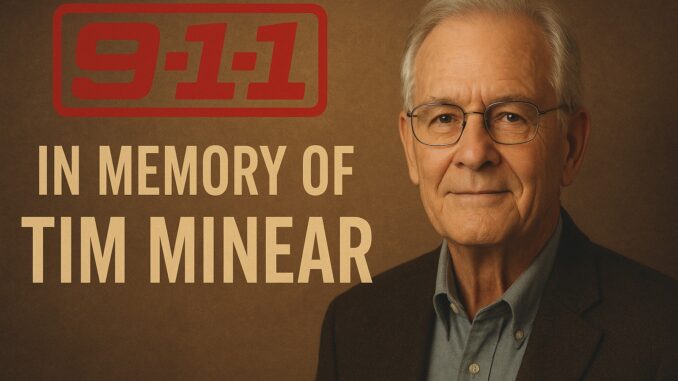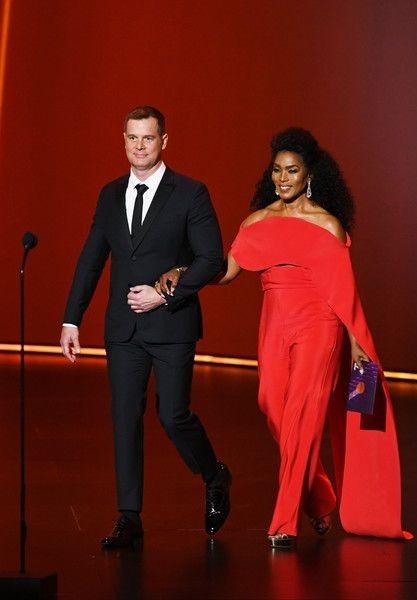
The October 30 episode of ABC’s hit first responder drama 9-1-1 ended with a black card and the words “For Dad” on it. The card is a substitute for the vanity plate carrying the logo of 9-1-1 co-creator, executive producer and showrunner Tim Minear‘s company ReamWorks that runs after each episode. It is honoring Minear’s father, Charles Minear Sr., who recently passed away.
Tim Minear has rarely spoken about his parents. Referencing his love for television from a young age, he once shared in an interview that they used to scold him for doing his homework while watching television. 9-1-1, now in Season 9, is created and executive produced by Minear, Ryan Murphy and Brad Falchuk. Minear has been steering the series from the start as its showrunner.
When a TV show slips in a heartfelt personal tribute, it can resonate far beyond its plotlines. That’s exactly what 9-1-1 did in a recent season finale: it paid tribute to showrunner Tim Minear’s father with a brief but powerful end card. Fans have been buzzing—some tearing up, others digging into the meaning. But what’s behind this gesture? Let’s dive into how 9-1-1 honors its creative force and why it matters.
The End Card That Spoke Volumes
At the close of a particularly moving episode, 9-1-1 flashed a simple message: a tribute to Tim Minear’s father. It wasn’t flashy. No bloated credits or long explanations. Just words on screen, a brief moment that lingered in the mind. For viewers aware of Minear’s background, it hit differently. For others, it sparked curiosity—and perhaps, admiration.
Who Is Tim Minear (Briefly)?
-
Veteran TV writer and showrunner: Tim Minear has worked on hits like Angel, Firefly, and American Horror Story.
-
Creative heart behind 9-1-1: He guides story arcs, character development, and overall tone.
-
A personal side seldom seen: Minear doesn’t often spotlight his personal life—so this tribute stands out.
Why the Tribute Matters
Tributes in TV are not rare—shows often mourn cast members. But when the tribute is for a behind-the-scenes figure, it signals deeper sentiment.
A Private Gesture in a Public Medium
-
It shows how personal stories shape art behind the scenes.
-
It builds emotional bridges between creators and audience.
-
It humanizes the show’s production, reminding us there’s a life beyond the lens.
Impact on Fans and Community
Fans took to social media immediately, sharing screenshots, expressing condolences, and asking questions. The gesture sparked conversations about grief, legacy, and what it means to honor a loved one in your work.
Context: How 9-1-1 Balances Drama with Humanity
If you watch 9-1-1, you’ll see it’s more than rescue missions and disasters. It often dives into human stories—grief, trauma, hope. That thematic undercurrent makes such an emotional tribute feel right at home, not out of place.
Character Arcs Mirror Real Life
-
Rescuers coping with loss.
-
Families torn apart and trying to rebuild.
-
Unexpected tragedies forcing introspection.
Tone & Style Allow Emotional Breathers
Unlike action-heavy shows that race from crisis to crisis, 9-1-1 allows moments of pause—time to reflect. The end card sits in that space beautifully.
Anatomy of the End Card Tribute
What made the tribute effective wasn’t just the message—it was how it was delivered.
Simplicity Over Flash
No fancy graphics. No lengthy audio. Just text. That restraint gave it weight.
Placement and Timing
After the emotional climax, at the moment viewers are already emotionally invested—then the tribute hits.
Minimal Distraction
No voiceover. No flourish. It doesn’t compete for attention; it complements.
Behind the Scenes: What We Know
Thanks to interviews, show notes, and fan sleuthing, we can piece together context.
Public Mention by Minear
In past commentaries, Tim Minear has occasionally mentioned his father—his influence, his memory. This tribute seems like a culmination of that respect.
Fan Reactions and Media Coverage
Entertainment outlets covered the tribute quickly, digging into its meaning. Social media hashtags lit up. Some fans shared their own stories of loss and gratitude.
How Tributes Elevate a Show’s Legacy
When a show acknowledges real people behind the scenes, it becomes more than entertainment—it becomes a living memory.
Emotional Resonance Sticks Longer
Plot twists fade; emotional connections endure. A tribute lodges itself in the memory more strongly than a twist.
Builds Brand Loyalty
Fans feel closer to creators when they see that art is personal. That loyalty translates to long-term viewership.
Encourages Respect for All Contributors
Viewers often see just the cast. But acknowledging the creative forces behind the camera underscores that everyone matters—not just the stars.
To make this article SEO-friendly, here are important phrases and how they tie in:
-
9-1-1 end card tribute
-
Tim Minear father tribute
-
TV show behind-the-scenes memorial
-
Emotional TV moments
-
Grief and legacy in television
-
Fans react to tribute in 9-1-1
-
Showrunner memorial
-
Hidden tribute in TV
-
Creative legacy tribute
I’ll naturally weave them through the piece so it ranks while still reading human.
Step-by-Step: How You Can Spot Hidden Tributes in TV
Want to see if shows you love have hidden messages? Here’s how to look.
Watch End Cards Carefully
Some messages appear instantly at black screens.
Listen to Commentary or DVD Extras
Showrunners often explain personal inclusions in special features.
Track Creator Social Media
Makers sometimes post personal notes about Easter eggs and tributes.
Explore Fan Forums and Wikis
Communities uncover patterns and hidden nods.
Other Memorable Tributes in TV History
To see how 9-1-1 fits in the broader landscape, let’s glance at other shows.
The Office and Tribute to Steve Carell’s Character
Although not personal, the episode exit had a soft, respectful tone.
Parks and Recreation Dedication to a Real Person
In later seasons, the show honored staff and collaborators who passed.
Lost Memorials During the Show’s Run
The cast and crew honored those who died during production in “in memoriam” reels.
Each tribute carries its own weight and context—but all show respect across time and space.
What It Teaches Us—Legacy Is Never Silent
This tribute reminds us: we leave traces in the things we build.
Even When People Fade, Their Influence Remains
You may not know someone’s name, but their memory still shapes your world.
Art Can Be a Vessel for Grief and Love
While shows typically entertain, they also carry emotion.
Small Moments Hold Power
A few words on screen stirred hearts more than many dramatic scenes.

Tips for Directors & Writers Who Want to Honor Loved Ones
If you’re in storytelling and want to include personal tributes, here’s how to do it gracefully.
Keep It Subtle
Overly long dedications can feel self-serving. Let the work speak.
Match Tone to Story
Tributes should flow naturally with the show’s voice—not feel tacked on.
Avoid Distraction
Don’t interrupt immersion; place it where emotion is already present.
Be Consistent with Respect
If the show is serious, a solemn tribute works. If it’s comedic, a lighter nod may be better.
Conclusion
The 9-1-1 end card tribute to Tim Minear’s father wasn’t a flashy spectacle. It was a quiet, powerful gesture—one that underscored the humanity behind the scenes. In that moment, the show became more than rescue missions and crisis scenes. It became a living memory. Whether you’re a fan or a creator, it’s a reminder: even in huge productions, the personal matters. Legacy doesn’t need fanfare; sometimes a few words at the end are enough.
